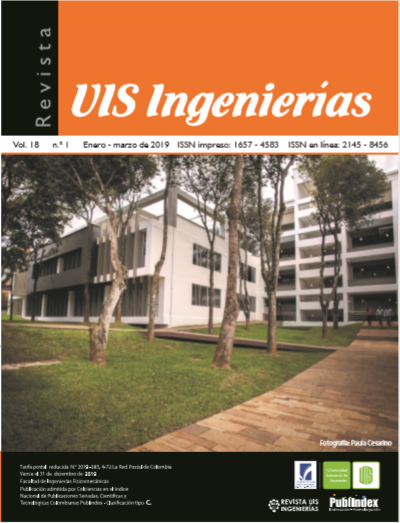Publicado 2019-01-01
Palabras clave
- duración hundimiento,
- energía,
- hundimiento de tensión,
- severidad
Cómo citar
Resumen
Para evaluar la cantidad de usuarios afectados por los hundimientos de tensión, se realiza una estimación de la energía no suministrada por el operador de red. Los hundimientos de tensión poseen un comportamiento dinámico, lo cual no es considerado por el método de cálculo impuesto por la normativa para evaluar sus efectos en la red. Por este motivo, esta investigación propone una metodología de análisis tensorial de hundimientos de tensión, que verifica el desbalance entre fases, la existencia de varios segmentos y la cantidad de fases afectadas. Como resultado, se presenta un análisis de los indicadores de hundimientos calculados para una base de datos del operador de red local utilizando la normativa y la metodología propuesta. Estos resultados son un insumo a las regulaciones nacionales para identificar los requerimientos en la cuantificación del impacto que generan los hundimientos de tensión.
Descargas
Referencias
A. Bendre, D. Divan, W. Kranz and W. E. Brumsickle, “Are voltage sags destroying equipment?,” in IEEE Industry Applications Magazine, vol. 12, no. 4, pp. 12-21, 2006. doi: 10.1109/MIA.2006.1678326
A. dos Santos and M. T. Correia de Barros, “Predicting Equipment Outages Due to Voltage Sags,” IEEE Transactions on Power Delivery, vol. 31, no. 4, pp. 1683-1691, 2016. doi: 10.1109/TPWRD.2015.2504352
I. Gu and M. Bollen, Signal processing of Power Quality Disturbances 1ra ed. New Jersey, USA: John Wiley and Sons Ltd, 2006.
J. Y. Chan and J. V. Milanovic, “Severity Indices for Assessment of Equipment Sensitivity to Voltage Sags and Short Interruptions,” 2007 IEEE Power Engineering Society General Meeting, Tampa, FL, 2007, pp. 1-7. doi: 10.1109/PES.2007.385457
H. Liao, S. Abdelrahman, Y. Guo and J. V. Milanović, “Identification of Weak Areas of Power Network Based on Exposure to Voltage Sags—Part I: Development of Sag Severity Index for Single-Event Characterization,” IEEE Transactions on Power Delivery, vol. 30, no. 6, pp. 2392-2400, 2015. doi: 10.1109/TPWRD.2014.2362965
H. Liao, S. Abdelrahman, Y. Guo and J. V. Milanović, “Identification of Weak Areas of Network Based on Exposure to Voltage Sags—Part II: Assessment of Network Performance Using Sag Severity Index,” IEEE Transactions on Power Delivery, vol. 30, no. 6, pp. 2401-2409, 2015. doi: 10.1109/TPWRD.2014.2362957
S. Z. Djokic and J. V. Milanovic, “Advanced voltage sag characterisation. Part I: Phase shift,” IEE Proceedings - Generation, Transmission and Distribution, vol. 153, no. 4, pp. 423-430, 13 July 2006. doi: 10.1049/ip-gtd:20050350
S. Z. Djokic, J. V. Milanovi!c and S. M. Rowland, “Advanced voltage sag characterisation II: point on wave,” IET Generation, Transmission & Distribution, vol. 1, no. 1, pp. 146-154, January 2007.
doi: 10.1049/iet-gtd:20050434
E. Cabezas-Jaimes “Optimal placement of voltage sag meters in distribution networks using fault location constains” SICEL, Bucaramanga, 2017, pp 253-261.
IEEE Recommended Practice for Monitoring Electric Power Quality, IEEE Standard 1159, 2009.
T. C. de Oliveira, J. M. de Carvalho Filho, R. C. Leborgne, G. T. Watanabe, J. P. G. de Abreu and J. F. de Oliveira, “Analysis of the relation between voltage sags severity and fault characteristics,” Proceedings of 14th International Conference on Harmonics and Quality of Power - ICHQP 2010, Bergamo, 2010, pp. 1-8. doi: 10.1109/ICHQP.2010.5625498
S. Arias-Guzman, A. J. Ustariz-Farfan and E. Cano-Plata, “Segmentation and characterization of voltage sags in the analysis of industrial circuits,” 2016 IEEE Industry Applications Society Annual Meeting, Portland, OR, 2016, pp. 1-8. doi: 10.1109/IAS.2016.7731944.
D. Gallo, C. Landi and M. Luiso, "Accuracy Analysis of Algorithms Adopted in Voltage Dip Measurements," IEEE Transactions on Instrumentation and Measurement, vol. 59, no. 10, pp. 2652-2659, Oct. 2010. doi: 10.1109/TIM.2010.2045256.
M. Caujolle, M. Petit, G. Fleury and L. Berthet, “Impact of Waveform Segmentation Accuracy on Disturbance Recognition Reliability,” Proc of IPST, Delf, Holanda, 2011.
M. Bollen and Ying Wang, “Voltage sag indices - future directions,” 2015 IEEE Power & Energy Society General Meeting, Denver, CO, 2015, pp. 1-13. doi: 10.1109/PESGM.2015.7286188
S. Arias-Guzman, A. J. Ustariz-Farfan, E. A. C. Plata and A. F. Salazar-Jimenez, “Implementation of IEEE Std 1564-2014 for voltage sag severity analysis on a medium voltage substation,” 2015 IEEE Workshop on Power Electronics and Power Quality Applications (PEPQA), Bogota, 2015, pp. 1-6. doi: 10.1109/PEPQA.2015.7168222
A. J. Ustariz-Farfán, “Formulación de una teoría tensorial de la potencia eléctrica: aplicaciones al estudio de la calidad de la energía,” Ph.D. dissertation, Universidad Nacional de Colombia-Sede Manizales, 2011.
S. Arias-Guzmán, “Hundimientos de tensión: un enfoque de análisis a partir del álgebra tensorial,” trabajo de fin de máster, Universidad Nacional de Colombia - Sede Manizales, 2015.

